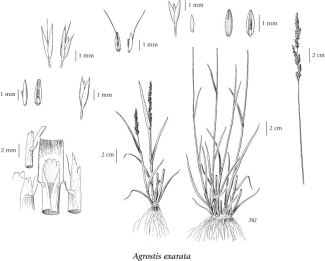Agrostis exarata Trin.
spike bentgrass
Poaceae (Grass family)
Introduction to Vascular Plants
spike bentgrass
Poaceae (Grass family)
Introduction to Vascular Plants
Species Information
General:
Perennial, tufted grass from fibrous roots, some of the shoots non-flowering; stems 20-100 cm tall.
Leaves:
Sheaths smooth to rough-hairy; blades 4-15 cm long, 2-8 mm wide, flat; ligules 2.5-4 mm long, rough-hairy outside.
Flowers:
Inflorescence spikelike, dense, narrowly egg-shaped or lanceolate, occasionally interrupted near the base, 4.5-18 cm long, the branches ascending or appressed, barely visible, densely covered with spikelets to the base; spikelets numerous, crowded; glumes 1.5-3.5 mm long, pointed or narrowly tapering to fine points, the surfaces smooth or rough-hairy, especially on the keels; lemmas 1.2-2.2 mm long, awnless or some awned from above the middle on the back, the awns to 3.5 mm long, straight or bent; calluses sparsely to abundantly hairy, the hairs to 0.3 mm long; rachillas not prolonged; paleas variable, absent or if present, only as a minute membrane to 0.5 mm long; anthers 0.3-0.6 mm long.
Notes:
A. exarata exhibits marked variation. Awned and awnless spikelets may occur on separate plants or in the same inflorescence. Plants also vary greatly in total height and size and colour of the inflorescence. For these reasons, several varieties have been proposed.
Illustration

If more than one illustration is available for a species (e.g., separate illustrations were provided for two subspecies) then links to the separate images will be provided below. Note that individual subspecies or varietal illustrations are not always available.
Illustration Source: The Illustrated Flora of British Columbia
USDA Species Characteristics
Flower Colour:
Yellow
Blooming Period:
Late Spring
Fruit/Seed characteristics:
Colour: Brown
Present over the Summer
Source: The USDA
Ecology
Ecological Framework for Agrostis exarata
The table below shows the species-specific information calculated from
original data (BEC database) provided by the BC Ministry of Forests and Range.
(Updated August, 2013)
The table below shows the species-specific information calculated from
original data (BEC database) provided by the BC Ministry of Forests and Range.
(Updated August, 2013)
| Site Information |
Value / Class |
||
|
Avg |
Min |
Max |
|
| Elevation
(metres) |
394 | 0 | 2500 |
| Slope
Gradient (%) |
9 | 0 | 97 |
|
Aspect (degrees) |
86 | 10 | 360 |
| Soil
Moisture Regime (SMR) [0 - very xeric; 4 - mesic; 8 - hydric] |
4 | 0 | 7 |
| Modal
Nutrient Regime
Class |
D | ||
| #
of field plots species was recorded in: |
183 | ||
| Modal
BEC Zone Class |
CWH | ||
|
All BEC Zones (# of stations/zone) species was recorded in |
AT(1), BWBS(2), CDF(20), CMA(1), CWH(109), ESSF(14), ICH(4), IDF(1), IMA(1), MH(5), MS(5), PP(2), SBPS(1), SBS(1) | ||
|
Source:
Klinkenberg 2013
|
|||
Habitat and Range
Mesic to wet fields, tidal marshes, beaches, meadows, river bars, roadsides and disturbed sites in the lowland, steppe and montane zones; common throughout BC; amphiberingian, N to AK, YT and NT, E to S SK, and S to TX, NM, AZ and CA; E Asia, S America.Status Information
Synonyms
Synonyms and Alternate Names:
Agrostis aenea Trin.
Agrostis alaskana Hultén
Agrostis ampla Hitchc.
Agrostis asperifolia Trin.
Agrostis exarata subsp. exarata
Agrostis exarata subsp. exarata
Agrostis exarata subsp. minor (Hook.) C.L. Hitchc.
Agrostis exarata var. minor Hook.
Agrostis exarata var. monolepis (Torr.) Hitchc.
Agrostis exarata var. pacifica Vasey
Agrostis exarata var. purpurascens Hultén
Agrostis longiligula Hitchc.
Agrostis longiligula var. australis J.T. Howell
Agrostis melaleuca (Trin.) Hitchc.
Agrostis microphylla var. major Vasey